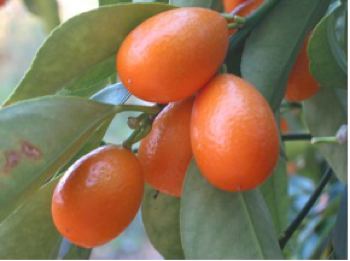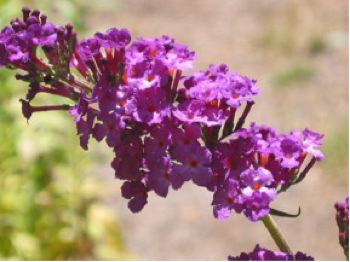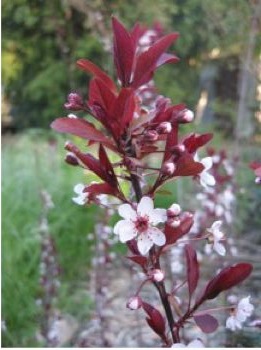Ten Tips for a Greener Garden
Originally published in the Davis Enerprise Mar. 27, 2008
 Lavender roses have been popular since Sterling Silver was introduced in 1957. But it is very prone to mildew, so gardeners have to spray frequently with fungicide. Lagerfeld, available since the 1980's, is more vigorous and disease-resistant.
Lavender roses have been popular since Sterling Silver was introduced in 1957. But it is very prone to mildew, so gardeners have to spray frequently with fungicide. Lagerfeld, available since the 1980's, is more vigorous and disease-resistant.
Do you remember when green was a color, not an adjective? In the garden business, green used to mean beautifying the world (remember Lady Bird Johnson?): greening up the world by planting trees and flowers. Now 'green' is a way of doing things in our lifestyle: reducing our carbon footprint, saving energy, reducing global warming.
Gardeners of my grandfather's generation used a regimen of fertilizing and preventive spraying, and kept their yards immaculate. These practices came at a cost. It was widespread use of the pesticide Dursban by homeowners that caused the EPA to remove it from the market. Nitrate can get into ground water, and phosphate can contaminate waterways. But though home gardeners made choices in the past with adverse consequences, we have many more options today and can choose wisely.
People who study plant diseases (plant pathologists) use a simple model that we can apply to other plant problems than just fungi and bacteria. They call it the Disease Triangle: for us to see a disease problem on a plant requires an interaction of the Host (the plant), the Pathogen (the problem), and the Environment (where the plant is growing).
In the past, solutions focused on the Pathogen: eradicate the fungus, sterilize the place, and that would solve the problem, right? But people who manage landscapes for a living begin to notice that the long term, simpler, and safer solution may be choosing the right plant in the first place, and growing it under the right conditions.
If I want a lavender rose, but Sterling Silver always gets mildew, perhaps I should plant Lagerfeld instead.
If my roses have rust fungus, which I know is a fungus with heavy spores that can move up a plant only by splashing with water, perhaps I should change my sprinklers to bubblers or drip.
 Know and attract your beneficial insects! Dragonflies, which eat whiteflies, are attracted to water. A fountain or small pond may draw them into your garden.
Know and attract your beneficial insects! Dragonflies, which eat whiteflies, are attracted to water. A fountain or small pond may draw them into your garden.
Some tips for a greener garden:
1. Choose easy plants.
This is the simplest step you can take! Most people enjoy seasonal color in their yards, even if they aren't avid gardeners.
Annuals
Bedding plants for summer: marigolds and petunias are notorious for pest problems. Why bother? Try dwarf Cosmos, annual Salvias, or the new dwarf hybrids of sunflowers or zinnias for the reds, oranges and yellows; Tapiens verbena or annual Vinca for pink, purple, and white.
Plant perennials!
There are hundreds of types to choose from, so I've narrowed it down in a couple of articles (Ten Easy Perennials, Showy Flowering Perennials).
Here are some of my top herbaceous perennials, at least at the moment:
- Achillea
- Alstroemeria
- Aster
- Coreopsis
- Dianthus
- Helleborus
- Hemerocallis
- Heuchera
- Narcissus and daffodils
- Penstemon
- Phygelius
- Rudbeckia
- Salvia
In the realm of woody perennials, I'd include
- Coleonema
- Euryops
- Lantana
- Lavandula
- Rosmarinus
- Salvia, again.
These shrubs can do double duty, serving as permanent woody plants while providing seasonal flowers.
 Choose the easier plant! Japanese Euonymus (left) is very prone to powdery mildew, necessitating frequent fungicide applications. Why not plant Pittosporum tobira ('Variegata' is shown at right) instead? More tolerant of shade, very amenable to pruning, and fragrant spring blossoms are highlights.
Choose the easier plant! Japanese Euonymus (left) is very prone to powdery mildew, necessitating frequent fungicide applications. Why not plant Pittosporum tobira ('Variegata' is shown at right) instead? More tolerant of shade, very amenable to pruning, and fragrant spring blossoms are highlights.
Shrubs
The backbone plants in your landscape don't have to be boring. Selected for seasonal bloom or foliage color, any of the following can also get big enough to provide privacy, create a focal point, or help define the separate areas of your yard.
Deciduous flowering shrubs provide short periods of spectacular color that mark the seasons:
- Chaenomeles
- Deutzia
- Forsythia
- Hydrangea quercifolia
- Ribes
- Roses
- Spiraea
- Syringa
- Vitex
Evergreen shrubs that have blooms over a long period, or during a special season:
- Abelia
- Buddleia
- Ceanothus
- Escallonia
- Mahonia aquifolium
- Roses, shrub and landscape types
- Viburnum tinus
Familiar plants that are not on this list? Azaleas, Camellias, Gardenias, Rhododendrons. None of these like our water, so they don't qualify as easy.
 Easy fruit in your backyard? Try kumquats or Meyer lemons, among the easiest citrus to grow. Both are naturally small trees, very productive, and have few pest problems. Shown is the Nagami kumquat, a popular variety with sweet rind and tart flesh. One of the hardiest citrus trees, it has edible fruit nearly year-around.
Easy fruit in your backyard? Try kumquats or Meyer lemons, among the easiest citrus to grow. Both are naturally small trees, very productive, and have few pest problems. Shown is the Nagami kumquat, a popular variety with sweet rind and tart flesh. One of the hardiest citrus trees, it has edible fruit nearly year-around.
2. Water correctly!
More plant problems are caused by overwatering or erratic watering than by drought. Surprising, perhaps, in our dry summer climate. But the fact is that most people water too often, and not deeply enough.
3. Have lawn where it matters.
Louis Sullivan, the architect, said "form ever follows function." Where we use a lawn it is worth the water and labor. Where we just need to cover the ground, there are less thirsty green plants. Lawn near the house, or where kids and dogs will play on it, can be beneficial.
Grass is a natural air conditioner: 1000 square feet of lawn puts 150 - 200 gallons of water into the air on a warm summer day. Water cools the air in this hot, dry climate. But choose your turf species for our climate: tall and dwarf fescues, or red fescue for the shade, are resistant to the fungus diseases prevalent on bluegrass lawns.
4. Plant for shade.
Plant shade trees strategically so they shade your house on summer afternoons. This is one garden choice you can make that directly saves energy! According to SMUD and the Sacramento Tree Foundation, "a mature tree canopy can reduce air temperatures in the summer by 5 to 10 degrees," and "a full-grown tree can reduce home cooling costs by up to 40 percent." Not to mention increasing property values and helping to clean the air!
No wonder SMUD gives away free shade trees. But trees can range from high maintenance (Calleryana pears) to zero maintenance (Ginkgo biloba). No other choice you make in your landscape has greater impact on the success of the rest of the landscape and on the value of your house at resale.
5. Use organic fertilizers.
The biggest obstacle to consumer acceptance of organic fertilizers (other than the odor�) has been that synthetic, aka traditional, fertilizers have been cheaper: for the total bag, and per unit of nitrogen. But that is changing. One of my vendors tells me that the cost of the nitrogen in their fertilizers increased 32% this year, and the cost of the phosphorus by 26%. Since some of these fertilizers are petroleum products, you might think the direct cost of oil is the major factor. But in fact it is a side effect of the greatly expanded acreage devoted to corn for production of ethanol. Corn farming uses lots of fertilizer. So the days of $5 bags of lawn food at the big box retailers may be past.
Organic fertilizers have many advantages, and some disadvantages. They are still somewhat more expensive when you compare the bags directly. But organic fertilizers break down and become usable to plants gradually, steadily, and mostly when the plants need them. The process of converting to available nitrogen from an organic source such as manure or blood meal takes place when weather is warm - i.e., when plants are growing. Until then, they leach very little, so there is little risk of runoff or contamination of water supplies.
Organic fertilizers are more effective if they are mixed with the soil, so they are most easily applied at the time of planting. One case where they may not provide enough food at the time the plant needs it would be for lawns in winter. Grass keeps better color and density, and resists fungus (rust) better, if it has good nitrogen levels in the winter. So a good feeding strategy for your lawn may be an organic source spring through early fall, and a November and January application of a traditional "winter" type lawn food.
 The landscape shrubs you choose can do double duty, providing screening and seasonal color. Butterfly bush (Buddleia) is a free-blooming shrub that attracts butterflies and hummingbirds to the garden. Virtually pest-free, it blooms all spring and summer.
The landscape shrubs you choose can do double duty, providing screening and seasonal color. Butterfly bush (Buddleia) is a free-blooming shrub that attracts butterflies and hummingbirds to the garden. Virtually pest-free, it blooms all spring and summer.
6. Fertilize sparingly: feed according to need.
You don't need to fertilize everything in your yard, or even most plants most of the time. Spraying foliar fertilizer on your garden every couple of weeks is unnecessary (though very profitable for the Miracle-Gro company!). It's more effective to incorporate slow-acting starter fertilizers at the time of planting, or broadcast a granular fertilizer once a few weeks later.
- Fertilize new transplants at the time of planting, and young trees in spring and fall for the first couple of years.
- Fertilize citrus monthly when young, seasonally when older. Apply micronutrients as needed.
- I apply special products to reduce the soil pH for certain acid-loving plants that I'm growing: blueberries, camellias, Japanese maples, gardenias; the same goes for azaleas, hydrangeas, and Loropetalum. Give them pH adjusters in spring and summer, or feed with special fertilizers labeled for them.
- Large-flowered roses will have more and larger flowers if they are fed monthly or seasonally, but types with smaller or clustered flowers don't need regular feeding.
- Feed your lawn seasonally: March, May, and September with a regular or organic lawn food, and November and January with a "winter type."
7. Make compost.
Rich garden soil is the secret of successful gardeners, and mineral soils such as we have in the West benefit from organic material. You can, of course, buy bags of compost. But you can also allow nature to recycle for you and compost the easy way, simply by piling up autumn leaves in strategic places about your landscape. A more formal compost pile is great, but as a first step you can just stop removing all this wonderful potential compost from your yard each fall. I take all the leaves that fall from my sycamore tree, and spread them out where next year's vegetables will be going.
 The landscape shrubs you choose can provide interesting foliage and seasonal color with very little effort on your part. This dwarf red-leaf plum (Prunus cistena) has burgundy foliage and showy spring flowers. It looks like the widely planted red-leaf plum tree (Prunus 'Krauter Vesuvius') but on a more compact plant.
The landscape shrubs you choose can provide interesting foliage and seasonal color with very little effort on your part. This dwarf red-leaf plum (Prunus cistena) has burgundy foliage and showy spring flowers. It looks like the widely planted red-leaf plum tree (Prunus 'Krauter Vesuvius') but on a more compact plant.
8. Manage pests safely.
Identify them first (nursery professionals are happy to help). Let nature manage them! Learn to recognize the many beneficial insects that take up residence in a garden of mixed flowers. Leatherwing beetles, which overwinter in leaf piles, eat aphids. Dragonflies, which eat whiteflies, are attracted to water features.
Before you spray for a pest, learn the lifecycle. Reach for a control measure only when damage exceeds your tolerance, and choose the least toxic alternative first.
9. Grow your own food.
Locally grown. Buy local. Slow food. There are movements afoot to get us off the Fast Food Nation mentality, to reduce the costs and consequences of our food production system (I recommend The Omnivore's Dilemma by Michael Pollan, for an interesting look at our food production system). The simplest and most direct thing you can do to cut those costs is to grow some food yourself.
We all know dedicated food gardeners, and can find them a little intimidating. My mother, now in her late 70's, has had a vegetable garden at some level for as long as I've known her. She is proud that something from her garden is on her dinner table nearly every day, whether fresh chard or Anaheim chiles from the freezer.
But nearly any back yard can produce some fruit, vegetables, or herbs. Crowd a bunch of lettuce greens, chard, kale, and radicchio into a pot for the winter, and keep it near the back door. A smaller variety of tomato can be planted in an oak barrel, together with Spicy Globe basil. Try Patio or Shady Lady for compact plants. Juliet and SunGold are small-fruited tomatoes that will yield even in partial shade.
Certain fruit trees are virtually pest free and require very little maintenance.
- Cherries, sweet and pie
- Citrus, especially (but not limited to):
- kumquats
- mandarins
- Meyer lemons
- oranges
- tangeloes
- Figs
- Persimmons
- Pomegranates
10. Pass it on.
Children learn to appreciate gardening when they see people enjoying it, when it is a pleasure not a chore, and when they see the results of their own projects. Every school in Davis has a garden, but with very limited resources of money and volunteers. Call your local school, ask for the school garden coordinator, and find out how you can help.
"Green" gardening means using environmentally friendly practices, which can also lead to safer, more successful, and more satisfying gardens.
© 2008 Don Shor, Redwood Barn Nursery, Inc., 1607 Fifth Street, Davis, Ca 95616
www.redwoodbarn.com
Feel free to copy and distribute this article with attribution to this author.
Click here for Don's other Davis Enterprise articles
